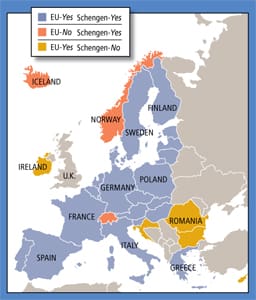While the European Union is probably the most widely known multination organization in Europe, there are other groupings of European countries formed to advance the common economic and cultural goals of the member states.
In addition to the European Union is the Schengen Area group of countries. This is comprised of 26 European nations that have abolished border control measures, such as border posts and passports, at borders with fellow member countries. The result is an area that generally is considered a single jurisdiction in terms of visa policy and international travel.
There are some European countries that are members of the EU but not signees to the Schengen Agreement. Likewise, there are some Schengen Area countries that are not EU member states (see accompanying illustration).
There are several international organizations to which European nations can belong, and many nations belong to more than one group. Some of these organizations are: the European Economic Area; the Eurozone; the Council of Europe; the Nordic Council (Scandinavian countries); Benelux (Belgium, the Netherlands and Luxembourg); the Central Europe Free Trade Agreement; the Visegrad Group (Czech Republic, Hungary, Poland and Slovakia); the Baltic Assembly; the Organization of the Black Sea Economic Cooperation; GUAM Organization for Democracy and Economic Development (Georgia, Ukraine, Azerbaijan and Moldova); and many others.

